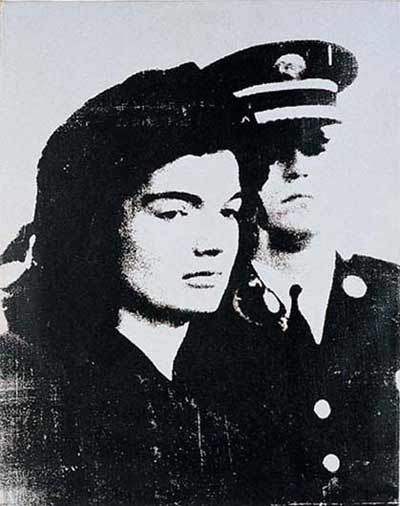 Andy Warhol: Jackie, 1964 Silkscreen on canvas Wolverhampton Art Gallery Faces in the Crowd Picturing Modern Life from Manet to Today Acconci, Ackerman, Alÿs, Arnold, Atget, Bacon, Balkenhol, Beckmann, Bellows, Beuys, Boccioni, Boltanski, Bomberg, Brassäi, Broodthaers, Buckingham, Burri, Cahun, Capa, Calle, Carrà, Cardiff & Bures-Miller, Cartier-Bresson, Deacon & Fraser, Deller, DiCorcia, Dittborn, Doherty, Song Dong, Dubuffet, Duchamp, Durant, Ensor, Export, Evans, Fast, Giacomelli, Gilbert & George, Goldblatt, Goldin, Gordon, Grosz, Gupta, Gursky, Guston, Guzman, Hamilton, Heartfield, Hopper, Huyghe, Jonas, Katz, Keita, Kentridge, Kirchner, Klucis, Kollwitz, Leckey, Léger, Levitt, Magritte, Manet, Man Ray, McCarthy, McQueen, Modotti, Munch, Muñoz, Nauman, Ofili, Paolozzi, Pfeiffer, Picasso, Piper, Pistoletto, Prince, Richter, Rodchenko, Sala, Sander, Schad, Schütte, Sherman, Schneemann, Segal, Sickert, Sidibé, Singh, Strand & Sheeler, Toulouse-Lautrec, Vertov, Wall, Warhol, Wearing, Weegee, Wikström, Winogrand, Yeats Taking Edouard Manet and key post-Impressionist masters as its starting point, "Faces in the Crowd" traces the story of modern art through representations of the individual and society. The exhibition's title is taken from a one-image poem by Ezra Pound: "The apparition of these faces in the crowd; petals on a wet, black bough", inspired by a journey on the Paris Metro in 1913. It gives a powerful evocation of the individual immersed within the modern metropolis. Moving through modern masters such as Max Beckmann, Francis Bacon and Jeff Wall, "Faces in the Crowd" maps social and individual relationships through a history of avant garde figuration. Transformations of the city through architecture and technology created public spaces of leisure and spectacle, which are explored in the works of Eugene Atget, Walter Sickert and Henri de Toulouse-Lautrec. The reduction of private identities to social type became the defining work of August Sander, while in more recent years Cindy Sherman has used different guises and identities to reinvent a sense of self. Artists such as Umberto Boccioni, Edvard Munch and Andy Warhol have used the figure to express sensations of speed, alienation or celebrity in modern life. Work on show by Eve Arnold, Robert Capa and Andreas Gursky documents the epic and the everyday. Whereas for artists including Alexander Rodchenko, Joseph Beuys and Chris Ofili, the figure becomes an agent of social change - revolutionary, transgressive or symbolic. Including painting, sculpture, photography and the moving image, this major art historical survey traces a story of modernism through its defining artists. Organised by the Whitechapel Gallery, London and Castello di Rivoli Museo d'Arte Contemporanea, Turin. Exhibition: 3 December, 2004 - 6 March, 2005 Gallery hours: Tue-Sun 11 am - 6 pm, Thursdays until 9 pm Whitechapel Art Gallery 80-82 Whitechapel High Street GB-London E1 7QX Telephone +44 20 7522 7878 (recorded information) Fax +44 20 7377 1685 Email info@whitechapel.org www.whitechapel.org |